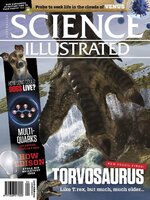Science Illustrated delivers natural science, break through discoveries and an understanding of the world for the entire family. Packed with stunning photography and in-depth editorial it’s a visually spectacular gateway to the world looking into the beginning of life to distant objects in the universe.
Science Illustrated
Cosmic collage: 3 billion stars in Milky Way portrait
Drowning in affection: frog mating ends in fatalities
SUBSCRIBE & START SAVING NOW!
Dying star swallows an entire planet • Astronomers may have observed Earth’s ultimate destiny in a Jupiter-sized planet 12,000 light years away.
Kissing gets an extra millennium • Clay tablets reveal that the earliest Mesopotamian communities in the Middle East were kissing – though with one unintended side effect.
Telescope spots asteroid belt around alien star • James Webb scores again, as the space telescope captures one of the night sky’s brightest stars with an unprecedented level of detail.
Electricity heals wounds three times faster
Pangenome to remove US gene bias • The original human genome project sequenced genes from multiple Americans whose identities were kept anonymous. For more globally-relevant information, we need a ‘pangenome’.
Saturn now has 146 moons • Using thousands of images plus inspiration from a classic children’s game, astronomers have discovered dozens of new moons that are orbiting Saturn.
Why is the sky blue? • Is it reflecting the ocean? Or is blue the colour of sunlight? And if the sky is blue, why and how does it turn red at sunset?
Why are menstrual cramps painful? And how painful are they really? • Menstruation is a natural part of a woman’s biology, but why can it become uncomfortable or even painful to menstruate? And can the pain be averted?
Can a snail repair its shell? • “I stepped on a snail by mistake, causing the shell to crack slightly. Can the snail leave its shell behind and exist without it, or can it grow a new one?”
What are dreams like for people who are blind?
How much energy remains in used nuclear fuel? • A lot of radioactive waste consists of ‘spent’ uranium rods from nuclear power plants. But are they fully ‘spent’? Couldn’t we still get some useful energy out of them?
How will humans survive the cold once they’re on Mars? • Mars is freezing cold – and showered in radioactive radiation. How are astronauts going to survive it?
Where did white dog poop go?
Is breathing improved with the mouth taped shut? • On TikTok, #mouthtape challenges have shown users taping their mouths shut before bed, so they breathe in their sleep only through their nose. Is this a good idea?
Why do magpies swoop at people and dogs?
Which vertebrate is the world’s smallest?
HOW ARE INJECTION NEEDLES MADE?
Are space stations close together? • In the 2013 film Gravity, the International Space Station, China’s Tiangong space station and the Hubble telescope were close enough to provide refuge. Is that realistic?
YOU’RE SO RANDOM… • New studies are showing that nature and nurture may play a smaller role than previously believed. In fact:
Twin experiments separate nature from nurture • By observing identical twins who grow up in different families, scientists can find out to what extent individual personality traits are controlled by either nature or nurture.
Random encounters form your personality • As the brains of children and teens develop, billions of new nerve cells encounter each other, causing the unpredicted formation of new nerve links – and hence influencing our personality.
5 characteristics describe your personality • Do you focus on a task, or are you more spontaneous and flexible? Get to know our five basic...

 Issue 111
Issue 111
 Issue 110
Issue 110
 Issue 109
Issue 109
 Issue 108
Issue 108
 Issue 107
Issue 107
 Issue 106
Issue 106
 Issue 105
Issue 105
 Issue 104
Issue 104
 Issue 103
Issue 103
 Issue 102
Issue 102
 Issue 101
Issue 101
 Issue 100
Issue 100
 Issue 99
Issue 99
 Issue 98
Issue 98
 Issue 97
Issue 97
 Issue 96
Issue 96
 Issue 95
Issue 95
 Issue 94
Issue 94
 Issue 93
Issue 93
 Issue 92
Issue 92
 Issue 91
Issue 91
 Issue 90
Issue 90
 Issue 89
Issue 89
 Issue 88
Issue 88
